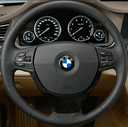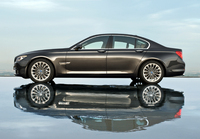Road Trip: 2009 BMW 7 Series - EXCLUSIVE VIDEO
Join us on a Road Trip in BMW's all new 7 Series
Produced and directed by Marc J. Rauch
In this week's episode of ROAD TRIP, Mark Fulmer accompanies BMW's Tom Plucinsky, Stephan Durach and Martina Starke in a drive from downtown San Diego to Apple Valley and back in the new 2009 7 Series sedan.
To ride along just click on the PLAY button below
SEE ALSO: BMW New Car Buyers Guide
The new BMW 7 Series: A technical ‘tour de force’
The launch of the new BMW 7 Series heralds the arrival of a host of
world-first driver and passenger-focused technologies. As the
world’s best selling luxury car, the four previous generations of BMW
7 Series have consistently offered the highest levels of technology, with
the first 750i of 1987 famously offering more computing power than NASA
utilised to put man on the moon. Now the latest BMW 7 Series has raised the
technological benchmark again.
 |
Night Vision is a familiar BMW technology that has been advanced and adapted for the new BMW 7 Series. BMW was the first to bring a Night Vision system to market but the new 7 Series also features another world first - Pedestrian Recognition. Scanning the road up to 300 metres ahead, much further than even the most powerful xenon headlamps, Night Vision highlights the shape and proximity of any heat sources that are close to the predicted path of the car. With Individual Pedestrian Recognition, the system uses video data and complex algorithms to predict if any pedestrians are behaving abnormally and are likely to move into the path of the car. The driver is alerted by warning symbols in the control display or the Head-up Display if specified.
 |
MORE: Read Marty Bernstein's review of the new 7 Series
Read Henny Hemmes' review of the new 7 Series
Side view cameras are a BMW first and are available as an option working alongside the standard Park Distance Control and optional Reversing Assist Camera. Using cameras mounted in the front bumper, the driver can see around obstacles or pull out of difficult junctions with confidence. Activated using a button in the centre console, the driver is presented with a split-screen view of both directions in the iDrive display.
Finally, BMW is the first premium manufacturer to offer Integral Active Steering (IAS) – effectively four wheel steering. IAS offers more direct steering responses and a smaller turning circle at slower speeds while, at higher speeds, delivers a more composed ride.



